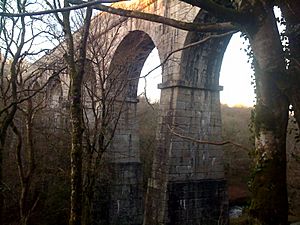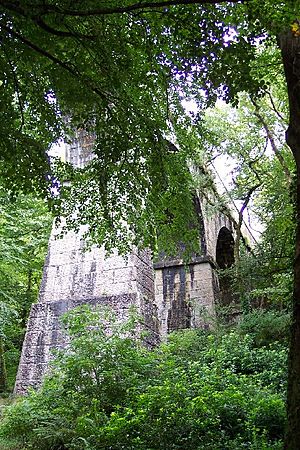Treffry Viaduct facts for kids
Quick facts for kids Treffry Viaduct |
|
|---|---|
| Carries | Combined viaduct and aqueduct |
| Crosses | Par River |
| Locale | Luxulyan Valley, Cornwall |
| Characteristics | |
| Material | Granite |
| Total length | 200 metres (660 ft) |
| Height | 27 metres (89 ft) |
| History | |
| Construction end | 1844 |
| Lua error in Module:Location_map at line 420: attempt to index field 'wikibase' (a nil value). | |

The Treffry Viaduct is a special bridge in Cornwall, United Kingdom. It's not just any bridge; it's a dual-purpose structure. This means it was built to do two jobs at once! It carried a railway line and also an aqueduct (a channel for water).
This amazing viaduct is found near the village of Luxulyan. It crosses the beautiful Luxulyan Valley. The viaduct and the valley are important parts of the Cornwall and West Devon Mining Landscape. This whole area is so special that it's a World Heritage Site. This means it's recognized globally for its history and importance. The viaduct is also a protected historic site.
Contents
Building the Treffry Viaduct
The story of the Treffry Viaduct begins with a man named Joseph Treffry. In 1813, he took over his family's lands. He was very keen to develop the area's natural resources, especially the minerals. He saw that the Luxulyan Valley was a perfect route. It connected the south coast of Cornwall to the higher lands in the middle of the county.
Joseph Treffry's Early Projects
Joseph Treffry started by building a new port at Par. This port was finished in 1829. He also created a canal that went up the valley to Ponts Mill. From there, he built a special inclined plane railway. This railway helped move things up a steep hill to the Fowey Consols mine. To power the mine, he built a water channel, called a leat, from Luxulyan.
Why a New Tramway Was Needed
Joseph Treffry also owned a port in Newquay and land near Goss Moor. He wanted to connect all these places with a railway system. Work on a smaller railway, called a tramway, started in 1835. But Joseph and his manager, William Pease, soon realized it wasn't big enough. So, they decided to build a much larger tramway instead.
The Great Viaduct's Construction
The new tramway included a steep inclined plane. This part went from the canal basin, past Carmears Rocks. It reached the top of the valley. Then, it ran level through Luxulyan to a place called Mollinis. To cross the river at a high level, they needed a huge bridge. This is why they built the Treffry Viaduct.
The viaduct was a massive engineering project for its time. It was about 198 meters (650 feet) long and 30 meters (100 feet) high. It was built using strong stone from local quarries. The lines from these quarries to the viaduct were the first parts of the tramway to open. The entire tramway was finished in 1844.
How the Viaduct Worked
The Treffry Viaduct was designed to carry both railway tracks and a water channel. This channel brought more water to the Fowey Consols mine. The design was very clever. The water channel had to be perfectly level for the water to flow correctly.
The water flowing down from the viaduct had another important job. It powered a large water wheel at Carmears. This wheel was 10 meters (34 feet) across. It helped the tramway move heavy loads up the steep incline.
Later Changes to the Railways
Joseph Treffry continued to improve his railway system. He extended the railway alongside the canal to Par Harbour. However, he passed away in 1850 before this part was fully completed.
Later, in 1872, a group of business people from London made big changes. They rebuilt Treffry's tramways to transport iron ore. They built a new route through the valley. This new route went under the Treffry Viaduct. It also crossed the River Par twice on other viaducts. This new railway was called the Cornwall Minerals Railway.
Visiting the Treffry Viaduct
The Treffry Viaduct is open to visitors all year round. It's free to explore! You can walk across the top of the viaduct. You can also view it from different spots across the valley.
There are places to park your car. One is at the bottom of the valley at Ponts Mill. Another is at the top of the valley, just north of the viaduct. You can also enjoy many walks to the viaduct from St Blazey village. Or, you can arrive by train at Luxulyan railway station. The train line passes right beneath the viaduct!
The Viaduct on Screen
The Treffry Viaduct has even appeared on television and in movies!
- In 2006, the BBC show Seven Man Made Wonders featured the viaduct.
- It was used as a filming location for the movie Omen III: The Final Conflict.
- In 2017, the viaduct was visited by Geoff Marshall and Vicki Pipe for their web series All the Stations.



